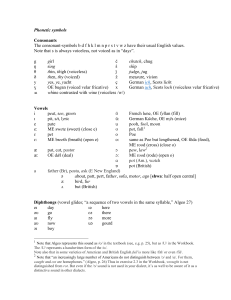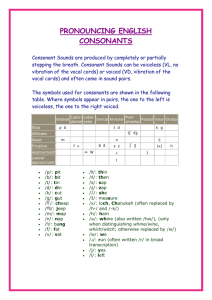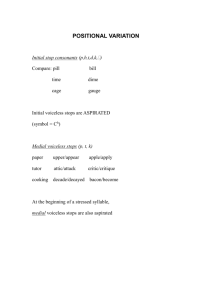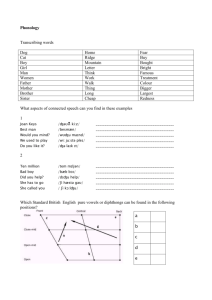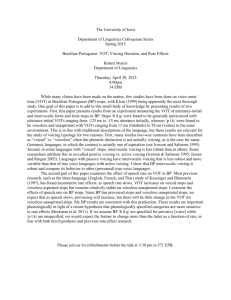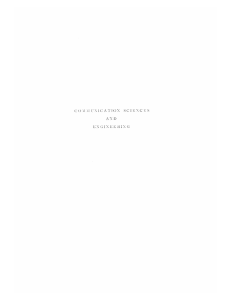manners of articulation - Serwis Informacyjny WSJO
advertisement
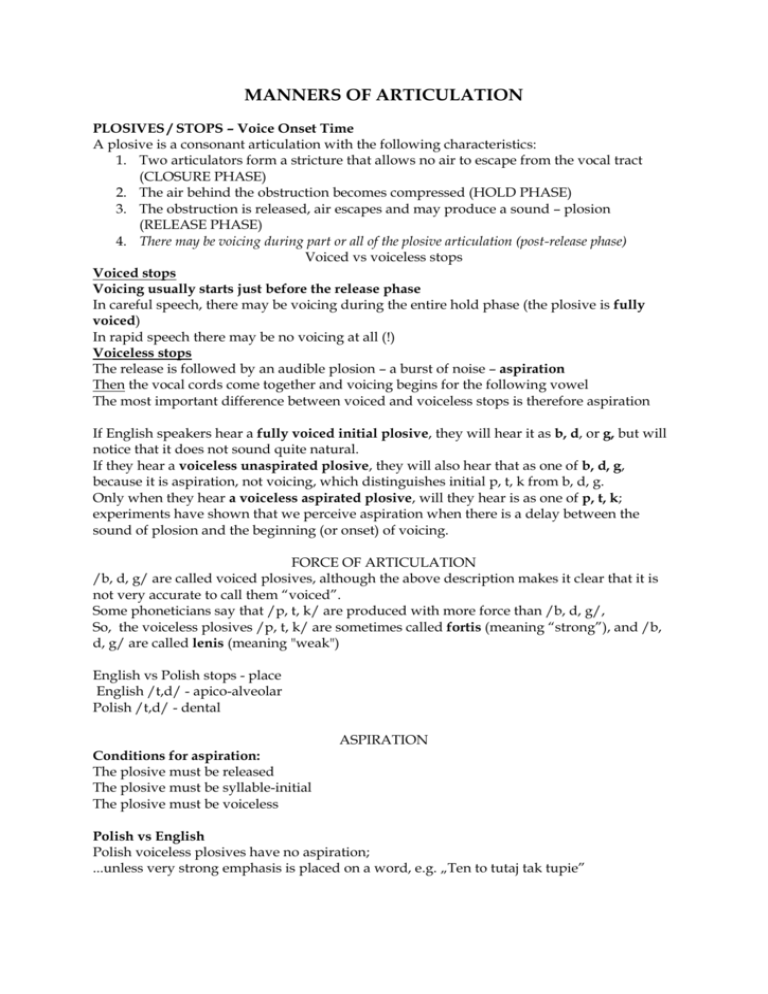
MANNERS OF ARTICULATION PLOSIVES / STOPS – Voice Onset Time A plosive is a consonant articulation with the following characteristics: 1. Two articulators form a stricture that allows no air to escape from the vocal tract (CLOSURE PHASE) 2. The air behind the obstruction becomes compressed (HOLD PHASE) 3. The obstruction is released, air escapes and may produce a sound – plosion (RELEASE PHASE) 4. There may be voicing during part or all of the plosive articulation (post-release phase) Voiced vs voiceless stops Voiced stops Voicing usually starts just before the release phase In careful speech, there may be voicing during the entire hold phase (the plosive is fully voiced) In rapid speech there may be no voicing at all (!) Voiceless stops The release is followed by an audible plosion – a burst of noise – aspiration Then the vocal cords come together and voicing begins for the following vowel The most important difference between voiced and voiceless stops is therefore aspiration If English speakers hear a fully voiced initial plosive, they will hear it as b, d, or g, but will notice that it does not sound quite natural. If they hear a voiceless unaspirated plosive, they will also hear that as one of b, d, g, because it is aspiration, not voicing, which distinguishes initial p, t, k from b, d, g. Only when they hear a voiceless aspirated plosive, will they hear is as one of p, t, k; experiments have shown that we perceive aspiration when there is a delay between the sound of plosion and the beginning (or onset) of voicing. FORCE OF ARTICULATION /b, d, g/ are called voiced plosives, although the above description makes it clear that it is not very accurate to call them “voiced”. Some phoneticians say that /p, t, k/ are produced with more force than /b, d, g/, So, the voiceless plosives /p, t, k/ are sometimes called fortis (meaning “strong”), and /b, d, g/ are called lenis (meaning "weak") English vs Polish stops - place English /t,d/ - apico-alveolar Polish /t,d/ - dental ASPIRATION Conditions for aspiration: The plosive must be released The plosive must be syllable-initial The plosive must be voiceless Polish vs English Polish voiceless plosives have no aspiration; ...unless very strong emphasis is placed on a word, e.g. „Ten to tutaj tak tupie” Variations of the release phase - Abrupt vs gradual release (stops vs affricates, /t - t∫/) - Nasal and lateral release (when /n/ /l/ or rarely /m/ follow stops which are produced at the same place of articulation, i.e. are homorganic) e.g. outlook, chutney, chipmunk - No release (in word-final positions and between morphemes) e.g. popcorn, firstclass; compare the Polish „odtwarzać, przedtem, oddać” FRICATIVES produced by close approximation of articulators so that friction can be heard Together with stops they are called obstruents, and are similar to stops in 3 ways: 1. they influence the length of the preceding vowel 2. final voiceless stops & fricatives are longer that final voiced stops & fricatives 3. voiced stops and fricatives are usually not voiced throughout the articulation unless adjacent sounds are also voiced, e.g. father, measure, eggs, table English vs Polish fricatives English: /s, z/ - apico-alveolar /∫, ž/ - tip of tongue /Ө, ð/ - interdentals /h/ - glottal fricative (friction between vocal cords); - has the quality of the vowel it precedes, e.g. Hanna, heat, horse – „a voiceless vowel”; - between voiced sounds it’s produced with voicing – breathy voice, e.g. ahead, greenhouse Polish: /s, z/ - dental /∫, ž/ - tip and blade of tongue /Ө, ð/ - non-existent /x/ - velar fricative - AFFRICATES stop + fricative, e.g. /t∫/ both sounds must be homorganic; compare church vs breakfast treated as one phoneme, e.g. church /t∫З:t∫/ - 3 phonemes Final voiced obstruents do not occur in Polish – final devoicing Some final notes... - Voiceless stops and affricates /p, t, k, t∫/ are longer than the corresponding voiced stops and affricates /b, d, g, „dż”/ when at the end of a syllable - Voiceless stops /p, t, k/ are unaspirated in words such as „spew, stew, skew” - In many accents of English, syllable final /p, t, k/ are accompanied by a glottal stop, as in pronunciations of „tip, pit, kick” /tI”?”p. pI”?”t, kI”?”k/ NASALS – air escapes through the nose – soft palate must be lowered; compare (buy, my): NASALS: - can be syllabic, e.g. button, cotton - /m, n/ occur freely - /ŋ/ never occurs initially – usually word-finally or medially: in monomorphemic words and grading adjectives we have /ŋg/, e.g. finger, anger, longer; in bimorphemic words we have /ŋ/, e.g. sing|er, hang|er, he long|s for sth. /ŋ/ can be preceded only by /I, e, æ, υ (less rounded), ∂, a, o/ /ŋ/ - normally not syllabic, except e.g. Jack and Katie English vs Polish nasals English: „need, university” - mechanical sum of /n + i or I/ /n/ is not palatalized, as in: „Pan i jego pies” Polish: „pani, koniec, niebieski” - A palatal nasal is used APPROXIMANTS /w, r, j, l/ Articulators approach each other, but not enough to produce a „complete” consonant The first three are central, /l/ is lateral are at least partially voiceless when they occur after initial /p, t, k/, as in „play, twin, cue” /l/ - closure: centre of tongue + alveolar ridge; air escapes along the sides of the tongue - can be syllabic, e.g. poodle - clear vs dark /l/ /r/ Palato-alveolar (post-alveolar) approximant Retroflex – tongue curled backwards /r/ has a voiceless allophone after /p,t,k/ e.g. tray, prize, cry In RP /r/ occurs only before vowels, and in final positions in rhotic accents, e.g. AmE trill – a series of intermittent closures, like Polish „r”, but less distinct; unlike in Polish, a trill only occurs intervocalically (between vowels) and occasionally, e.g. in Scottish - /j & w/ Palatal /j/ and bilabial (& velar) /w/, sometimes called semivowels Phonetically like vowels /i: & u:/, but phonologically like consonants: 1. They only occur between vowel phonemes – typical of consonants 2. a way, a year, an apple 3. the way, the apple • Can be devoiced, e.g. twin, tune, queen, queue, pure NUMBER OF CONSONANTS English -24; Polish - 29
